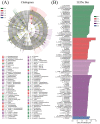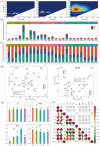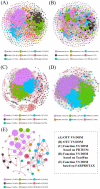Linking Shifts in Bacterial Community Composition and Function with Changes in the Dissolved Organic Matter Pool in Ice-Covered Baiyangdian Lake, Northern China
- PMID: 32545218
- PMCID: PMC7357102
- DOI: 10.3390/microorganisms8060883
Linking Shifts in Bacterial Community Composition and Function with Changes in the Dissolved Organic Matter Pool in Ice-Covered Baiyangdian Lake, Northern China
Abstract
The relationship between CDOM (Chromophoric dissolved organic matter) and the bacterial community was investigated in ice-covered Baiyangdian Lake. The results showed that environmental parameters significantly differed in Baiyangdian Lake, whereas a-diversity was not significantly different. Moreover, the microbial and functional communities exhibited significant differences, and T (Temperature), pH, ORP (Oxidation-reduction potential), DO (Dissolved oxygen), NO3--N, NH4+-N, and Mn (Manganese) were the main environmental factors of these differences, based on redundancy analysis and the Mantel test. Biomarkers of the microbial and functional communities were investigated through linear discriminant analysis effect size and STAMP analysis. The number of biomarkers in the natural area was highest among the typical zones, and most top functions were related to carbohydrate metabolism. Two protein-like components (C1 and C2) and one humic-like component (C3) were identified by parallel factor analysis, and C1 was positively related to C2 (R = 0.99, p < 0.001), indicating the same sources. Moreover, CDOM significantly differed among the typical zones (p < 0.001). The high biological index, fluorescence index, β:α, and low humification index indicated a strong autochthonous component and aquatic bacterial origin, which was consistent with the results of UV-vis absorption spectroscopy. Network analysis revealed non-random co-occurrence patterns. The bacterial and functional communities interacted closely with CDOM. The dominant genera were CL500-29_marine_group, Flavobacterium, Limnohabitans, and Candidatus_Aquirestis. Random forest analysis showed that C1, C2, and C3 are important predictors of α- and β-diversity in the water bacterial community and its functional composition. This study provides insight into the interaction between bacterial communities and DOM (Dissolved organic matter) in ice-covered Baiyangdian Lake.
Keywords: Bacterial community; Baiyangdian Lake; Excitation-emission matrix-parallel factor analysis (EEM-PARAFAC); Functional composition; Network analysis; chromophoric dissolved organic matter (CDOM).
Conflict of interest statement
The authors declare no conflict of interest
Figures








References
-
- Ávila M.P., Brandão L.P.M., Brighenti L.S., Tonetta D., Reis M.P., Stæhr P.A., Asmala E., Amado A.M., Barbosa F.A.R., Bezerra-Neto J.F., et al. Linking shifts in bacterial community with changes in dissolved organic matter pool in a tropical lake. Sci. Total Environ. 2019;672:990–1003. doi: 10.1016/j.scitotenv.2019.04.033. - DOI - PubMed
-
- Stedmon C.A., Markager S. Resolving the variability in dissolved organic matter fluorescence in a temperate estuary and its catchment using PARAFAC analysis. Limnol. Oceanogr. 2005;50:686–697. doi: 10.4319/lo.2005.50.2.0686. - DOI
-
- Zhou Y., Li Y., Yao X., Ding W., Zhang Y., Jeppesen E., Zhang Y., Podgorski D.C., Chen C., Ding Y., et al. Response of chromophoric dissolved organic matter dynamics to tidal oscillations and anthropogenic disturbances in a large subtropical estuary. Sci. Total Environ. 2019;662:769–778. doi: 10.1016/j.scitotenv.2019.01.220. - DOI - PubMed
Grants and funding
LinkOut - more resources
Full Text Sources
Miscellaneous

